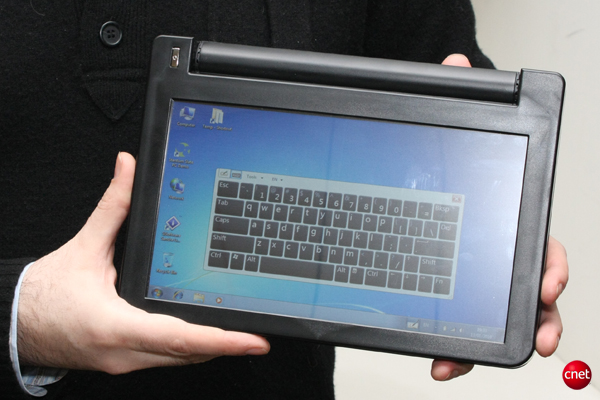



Feature Story
More feature stories by year:
2024
2023
2022
2021
2020
2019
2018
2017
2016
2015
2014
2013
2012
2011
2010
2009
2008
2007
2006
2005
2004
2003
2002
2001
2000
1999
1998
Return to: 2010 Feature Stories
CLIENT: STANTUM
Jan. 15, 2010 : CNET
![]() At CES 2010, Dell got a lot of attention from its concept model 5-inch slate. Though only briefly shown at Dell's CES press conference, we got a chance to play around with a demo unit behind the scenes, and came away feeling like it was a slightly jazzed-up smartphone, rather than a true tablet PC.
At CES 2010, Dell got a lot of attention from its concept model 5-inch slate. Though only briefly shown at Dell's CES press conference, we got a chance to play around with a demo unit behind the scenes, and came away feeling like it was a slightly jazzed-up smartphone, rather than a true tablet PC.
Although that concept device may never be released, we've spent the past two days tapping, swiping, and flipping on a new Dell tablet PC, with a 10-inch multitouch display and powered by an Intel Atom processor.
The device is actually a prototype tablet built by French multitouch technology company Stantum. The company started with a stock Dell Mini 10 Netbook, deconstructed it, removing the screen and keyboard, and rebuilt it with a resistive touch screen--all to demo its touch-display know-how.
If that sounds like a familiar concept, you may have read our review of the Axiotron Modbook, which is a touch-screen Apple tablet device made from a reconstructed MacBook laptop.





Hands-on with the prototype
Turning on the tablet for the first time, our expectations were modest, as the system uses an older Intel Atom Z520 CPU, which can barely run a non-touch-screen Netbook under the best of circumstances. And though overall performance was sluggish, we were actually very pleasantly surprised by how speedy and responsive the touch interface was.
Using just Windows 7's built-in onscreen keyboard and touch functionality, we were able to navigate the Internet with relative ease, and scrolling through long Web pages was easier than on most retail tablets we've tried (although the scroll-down function seemed to be more responsive than the scroll-up function).
Still, though speedy, the touch interaction was not on par with the lag-less experience one usually gets from an iPhone or an iPod Touch. This may be in part because this is a resistive touch screen, rather than a capacitive one; that means it senses pressure as well. On the plus side, it can register different effects based on how much pressure you use with your fingers (if supported by a software app), but it also requires a slightly firmer touch than you may be used to.
More impressive is the fact that this display can handle up to 10 simultaneous inputs. We put it the test in a paint program, by dragging all our fingers across the screen at once, turning each one into an independent paintbrush. Again, it's the kind of thing that really requires a compatible software package to take advantage of.

A good Kindle alternative?
Last year we looked at Netbook alternatives to the Amazon Kindle e-book reader, as both the Kindle and your average Netbook were around $300 to $400, and had roughly similar-size screens. We argued that book reading software was available for PCs, and combined with color screens, full operating systems, Web browsers, and multimedia capabilities, a Netbook might be a better bang for your buck as an e-book device.
Since that time, Amazon has released a Kindle app for the PC, and this keyboard-less slate device seemed like the perfect opportunity to try it out. We loaded up the software, logged into our Amazon account, and were able to access our books immediately. It was a slight hassle, but we also popped into the Windows display options and flipped the screen from landscape to portrait mode, to better approximate the Kindle experience.
Now, viewing a book on a bright PC screen is not as comfortable for long-term reading sessions as e-ink, but our mock Kindle had several advantages the real devices do not. Besides the color screen, we were also able to make use of the touch functionality to literally flip the pages of our book, making for a much more organic feel than hitting the next-page button on a dedicated e-book reader and waiting for the monochrome display to flash itself onto the next page of text.
Of course, using the onscreen keyboard and other Windows tablet functions will only get you so far, especially when you're working in the standard Win 7 environment, and not a touch-friendly custom UI. That's part of the reason everyone was so knocked out by Lenovo's U1 Hybrid at CES 2010; the tablet display could dock with the keyboard to form a standard laptop, for those times when you just need to fire up a keyboard and touch pad.
As a proof-of-concept prototype, we were impressed by Statum's device, and how it made the most of an underpowered Netbook platform (the company is currently taking order inquiries if you want one of its handmade prototypes for around $1,000). We're sure we'll see more tablet and slate devices throughout 2010, from companies such as Dell, HP, Lenovo, and, of course, Apple. The basic technology seems to be ready for widespread use, but the real test will be in creating user interfaces and software apps that don't feel tacked on to the traditional keyboard-and-mouse experience.
Return to: 2010 Feature Stories